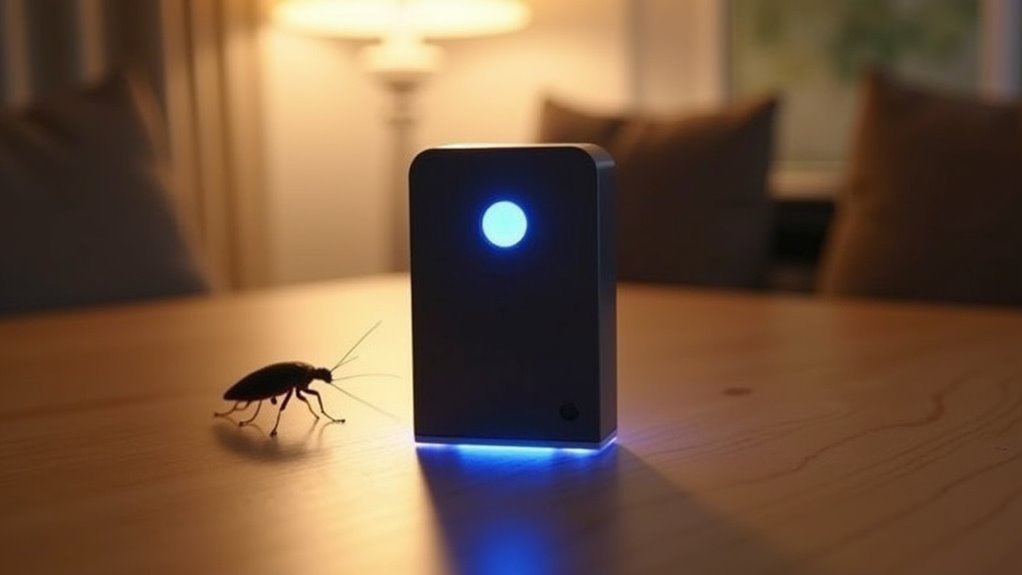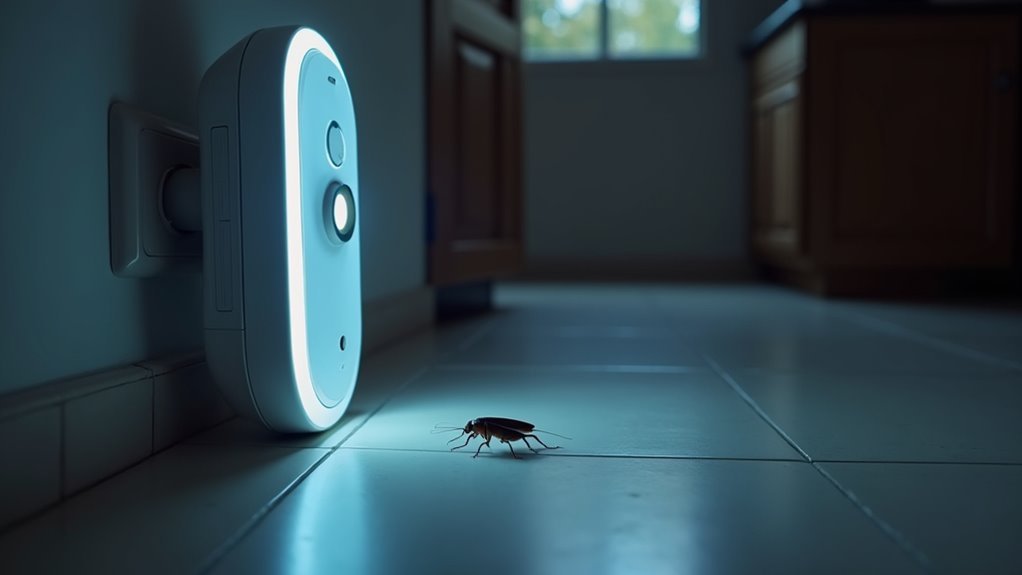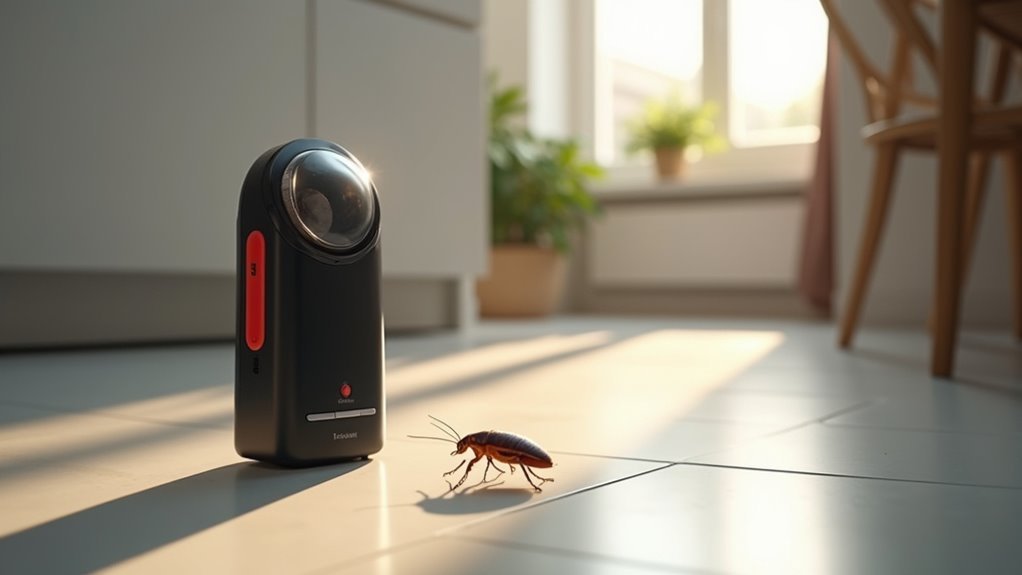Ultrasonic pest repellers won’t effectively stop roaches in your home, despite manufacturers’ promises. These devices emit high-frequency sound waves between 20-65 kHz that cockroaches can detect through specialized sensory hairs, but Kansas State University studies show they cause increased movement rather than fleeing behavior. Roaches quickly adapt to continuous ultrasonic exposure, and sound waves can’t penetrate walls or furniture, creating hiding spots where pests remain undisturbed. Understanding why these limitations exist will help you choose more effective cockroach control methods.
What Are Ultrasonic Pest Repellers and How Do They Work

Ultrasonic pest repellers promise a chemical-free solution to your cockroach problem by emitting high-frequency sound waves between 20 kHz and 65 kHz.
These pest control devices operate by plugging into standard electrical outlets, where they continuously broadcast ultrasonic frequencies that remain completely inaudible to human ears.
Ultrasonic repellers plug into wall outlets and emit continuous high-frequency sounds that humans cannot hear.
The theory behind these devices centers on disrupting cockroaches’ normal behaviors through constant sound exposure. You’ll find that manufacturers claim these ultrasonic frequencies create confusion and distress in roaches, theoretically making your home an inhospitable environment that drives them away.
When you activate these repellers, they emit high-frequency sound waves designed to penetrate areas where cockroaches typically hide and travel.
The continuous operation means you’re maintaining consistent pressure against potential infestations without using chemicals or traps.
The Science Behind High-Frequency Sound Waves and Cockroach Detection
You might wonder how cockroaches actually detect the high-frequency sounds that ultrasonic repellers produce.
These insects possess specialized sensory hairs called cerci that can pick up sound waves, including those in the ultrasonic range that humans can’t hear.
Understanding how cockroaches process these frequencies will help you evaluate whether ultrasonic devices can effectively repel them from your home.
How Cockroaches Hear Sounds
Cockroaches detect sounds through specialized sensory hairs called “aerials” on their antennae, which pick up vibrations and sound waves in their environment.
These insects perceive frequencies between 1 kHz and 10 kHz, making them sensitive to low-frequency sounds but less responsive to higher frequencies.
When ultrasonic pest repellers emit high-frequency sound waves (typically 20-65 kHz), cockroaches can detect these frequencies despite them being inaudible to humans.
However, scientific evidence reveals surprising results about their actual effectiveness.
- Cockroaches often increase movement when exposed to ultrasonic frequencies rather than fleeing.
- Their specialized antennae detect vibrations but don’t necessarily interpret them as threats.
- Kansas State University studies show no significant behavioral changes from ultrasonic exposure.
- Higher frequencies may cause confusion but rarely produce the intended deterrent effect.
Ultrasonic Frequency Range Effects
When pest control devices blast sound waves between 20 kHz and 65 kHz, they’re targeting frequencies well above human hearing range but within cockroaches’ detection capabilities. These ultrasonic devices emit high-frequency sounds through specialized sensory hairs that cockroaches use for detection.
However, research reveals a disappointing reality. Kansas State University studies show German cockroaches display minimal behavioral changes when exposed to these frequencies. Instead of fleeing, roaches often increase movement without actual repulsion.
| Frequency Range | Cockroach Response | Effectiveness |
|---|---|---|
| 20-35 kHz | Increased activity | Low |
| 35-50 kHz | Temporary detection | Minimal |
| 50-65 kHz | Quick adaptation | Poor |
The devices face additional challenges: sound waves can’t penetrate walls or furniture, limiting coverage. Most concerning, cockroach populations adapt quickly, becoming habituated to constant ultrasonic exposure over time.
Kansas State University Study Results on Cockroach Behavior

Although ultrasonic repellers claim to drive away cockroaches through high-frequency sound waves, research from Kansas State University reveals a different story. Their thorough study examined how pest repellers use ultrasonic frequencies and found minimal effect on cockroaches.
While German cockroaches showed increased movement when exposed to these sounds, they displayed virtually no avoidance behavior.
The Kansas State University research uncovered several critical findings about the effect on cockroaches:
- Cockroaches habituate to ultrasonic noise over time, reducing any potential deterrent impact.
- Despite ultrasonic exposure, roaches continue thriving in treated areas without significant population reduction.
- Increased movement doesn’t translate to actual repellent behavior or area avoidance.
- Other insects like crickets showed better response rates compared to cockroaches.
These findings challenge the effectiveness claims surrounding ultrasonic pest control devices.
Why Ultrasonic Devices Affect Different Pests Differently
Understanding why ultrasonic devices don’t work equally on all pests requires examining how different insects process sound. When pest repellers emit high-frequency waves between 20-65 kHz, each species responds uniquely based on their biological makeup.
Cockroaches possess specialized sensory hairs that detect sounds, but they’re remarkably adaptable creatures. They simply adjust to ultrasonic noise over time, making them resilient pests that don’t flee as expected. Crickets, however, show increased movement when exposed to these frequencies, demonstrating heightened sensitivity.
| Pest Type | Response to Ultrasonic | Adaptation Rate | Effectiveness |
|---|---|---|---|
| Cockroaches | Minimal behavioral change | High | Poor |
| Crickets | Increased movement | Moderate | Variable |
This biological variation explains why you’ll see mixed results when using ultrasonic repellers across different pest species.
Regulatory Status and Lack of EPA Testing Requirements

You’ll find that ultrasonic pest repellers operate in a regulatory gray area since they’re not covered under FIFRA like chemical pesticides.
The EPA doesn’t require manufacturers to test these devices for effectiveness or safety before they hit the market.
This means you’re purchasing a product that hasn’t undergone the same scrutiny as traditional pest control methods.
FIFRA Regulation Gap
Unlike chemical pesticides that must undergo rigorous EPA testing and approval, ultrasonic pest repellers exist in a regulatory gray area where manufacturers aren’t required to prove their effectiveness against cockroaches.
This FIFRA regulation gap means ultrasonic technology bypasses the same scientific scrutiny that chemical pesticides face before reaching store shelves.
You’re fundamentally purchasing products without federal oversight guaranteeing their pest control claims.
While the EPA demands extensive safety and efficacy data from traditional pesticide manufacturers, ultrasonic device makers can market their products without providing scientific evidence supporting roach elimination promises.
- Manufacturers aren’t required to submit effectiveness studies to federal agencies
- Claims about cockroach elimination don’t need scientific validation before marketing
- You lack federal protection against misleading ultrasonic pest control advertising
- Traditional chemical pesticides undergo years of testing that ultrasonic devices avoid
No EPA Testing
Pest control professionals often express skepticism about these products precisely because they lack EPA-required efficacy studies.
When you purchase an ultrasonic repeller, you’re participating in what amounts to an uncontrolled experiment in your own home.
The absence of mandatory testing creates a dangerous information void where marketing claims replace scientific evidence, leaving consumers to determine effectiveness through trial and error.
Real Consumer Experiences and Mixed Review Analysis
Anyone searching for honest feedback about ultrasonic roach repellers will find themselves wading through a sea of contradictory reviews that tell vastly different stories.
Consumer reviews reveal a frustrating pattern: some users swear they’ve seen fewer cockroaches after installing these electronic devices that emit high-frequency sounds, while others report zero improvement in their pest problems.
The Kansas State University study adds scientific context, showing cockroaches actually increase movement when exposed to ultrasonic frequencies rather than fleeing.
Many reviewers mention waiting weeks for results that never materialize, with some expressing particular frustration about mice continuing to nest despite running repellers continuously.
- Scientific studies contradict manufacturer claims about repelling behavior
- Timeline expectations often don’t align with actual results
- Lack of regulatory oversight creates unreliable product standards
- Success stories appear inconsistent and difficult to replicate
Physical Limitations of Sound Wave Penetration in Homes
Even when ultrasonic repellers function as designed, the physics of sound wave transmission severely limits their effectiveness throughout your home.
Your walls, furniture, and other physical barriers easily obstruct the 20 kHz to 65 kHz sound waves these devices emit. This creates significant dead zones where roaches can hide undisturbed.
The limited range means you won’t get complete room coverage, let alone whole-house protection.
Sound waves struggle with penetrating dense materials like drywall, wood, and fabric, preventing ultrasonic frequencies from reaching pests in cabinets, behind appliances, or inside wall voids—precisely where roaches prefer to nest.
You’ll also face power dependency issues.
When outages occur, your ultrasonic devices stop working entirely, creating gaps in whatever minimal deterrence they might provide.
Cockroach Habituation to Continuous Ultrasonic Exposure
Beyond the physical limitations of ultrasonic waves, cockroaches themselves present an even more fundamental problem for these devices.
You’ll discover that cockroach habituation occurs rapidly when exposed to continuous ultrasonic exposure. Kansas State University research shows that while roaches initially display increased movement, they don’t actually leave their environment.
Within days, they’ll learn to ignore the high-frequency sounds completely. Your pest control devices become fundamentally useless as cockroaches adapt their behavior.
They’ll continue breeding, foraging, and living normally despite the constant ultrasonic bombardment. This habituation process negates any temporary disruptive effects you might’ve initially observed.
- Habituation occurs within days of continuous exposure
- Initial movement increase doesn’t equal effective repelling
- Cockroaches continue normal activities after adaptation
- Long-term pest control effectiveness becomes negligible
Potential Side Effects on Humans and Household Pets
While ultrasonic repellers might seem harmless since you can’t hear them, these devices can create unexpected problems for both you and your pets.
British researchers have documented potential side effects including headaches and irritability from prolonged exposure to ultrasonic frequencies. Your small pets face greater risks—rabbits and guinea pigs show particular sensitivity due to their heightened ability to detect these sound waves.
While your dogs and cats typically aren’t affected, individual reactions vary, so you should watch for signs of distress.
These devices can also interfere with your telecommunications, disrupting phone calls and alarm systems. The Federal Trade Commission has raised safety concerns about these products, questioning both their effectiveness and impact on humans and pets.
Comparing Ultrasonic Repellers to Traditional Roach Bait Stations
When you’re deciding between ultrasonic repellers and traditional roach bait stations, you’re fundamentally choosing between unproven technology and scientifically-backed pest control methods.
Kansas State University studies show ultrasonic pest repellers work poorly against cockroaches, while traditional roach bait stations consistently deliver results.
- Effectiveness: Bait stations contain poison that directly kills roaches, while ultrasonic devices emit questionable sound waves.
- Scientific backing: Research supports bait stations’ success in reducing populations versus minimal impact from ultrasonic repellers.
- Practical considerations: Bait stations work continuously without electricity and aren’t blocked by furniture or walls.
- Professional recommendations: Pest control experts consistently choose bait stations over ultrasonic devices.
You’ll eliminate cockroaches more reliably with bait stations than ultrasonic repellers.
Professional Pest Control Vs DIY Electronic Solutions
You’ll face a clear choice between hiring trained professionals who conduct thorough inspections and applying targeted treatments versus relying on DIY electronic devices with questionable effectiveness.
Professional pest control technicians bring expertise that adapts to your home’s specific layout and infestation severity, while ultrasonic repellers offer a one-size-fits-all approach that studies show has little impact on cockroach behavior.
The upfront cost of professional services often proves more economical than repeatedly purchasing electronic solutions that don’t deliver consistent results.
Professional Training Vs DIY
Because professional pest control technicians undergo extensive training in pest identification, infestation assessment, and targeted treatment application, they consistently deliver more reliable results than homeowners attempting DIY electronic solutions.
You’ll find that professional pest control services utilize advanced baiting systems and treatment methods unavailable to consumers, while DIY methods like ultrasonic repellers lack scientific backing and show mixed results against cockroaches.
Without proper training, you can’t effectively apply control methods, often leading to worsening infestations.
Though DIY electronic devices seem cost-effective initially, professional services provide thorough inspections, customized treatment plans, and follow-up care that ultimately save you time and money.
- Professional technicians access commercial-grade products unavailable to homeowners
- Detailed inspections identify root causes DIY solutions miss
- Customized treatment plans target specific pest behaviors and entry points
- Follow-up services guarantee long-term elimination rather than temporary deterrence
Cost Effectiveness Analysis
Most homeowners discover that professional pest control services, despite their higher upfront costs of $100-$300 per visit, deliver superior long-term value compared to DIY electronic solutions that often fail to eliminate roach infestations.
While ultrasonic devices appear cheaper initially, you’ll likely need repeated purchases since they’re scientifically proven ineffective against roaches.
Professional pest control includes follow-up treatments and prevention strategies that reduce overall expenses while actually solving your problem.
When you rely on ultrasonic devices, you risk ongoing infestations that cost more money over time and expose your family to health hazards from disease-carrying cockroaches.
The true cost isn’t just monetary—it’s your family’s safety and peace of mind that professional services protect effectively.
Cost-Effectiveness Analysis of Ultrasonic Device Investment
While ultrasonic pest repellers carry an attractive upfront price tag of $20 to $50 per unit compared to professional pest control services that start at $100, their questionable effectiveness makes them a potentially poor investment.
You’ll likely find yourself spending additional money on proven pest control methods when ultrasonic devices fail to eliminate roach populations.
The cost-effectiveness of ultrasonic devices becomes questionable when you consider:
- Studies show limited to no impact on cockroach behavior
- Mixed user results often require supplemental pest control strategies
- Lack of regulation means efficacy claims aren’t scientifically backed
- You may end up paying twice – once for the device, then for effective solutions
Professional services or proven baiting systems might cost more initially but deliver reliable results.
Alternative Eco-Friendly Cockroach Control Methods
If you’re seeking alternatives to ultrasonic repellers, several eco-friendly methods can effectively control cockroach populations in your home.
You can create natural bait stations using non-toxic substances, apply boric acid in strategic locations where roaches travel, or spray essential oil deterrents around entry points and problem areas.
These methods often prove more reliable than ultrasonic devices while maintaining your commitment to environmentally safe pest control.
Natural Bait Stations
When you’re seeking a safer alternative to chemical pesticides, natural bait stations offer an effective solution that uses food-grade ingredients like boric acid and diatomaceous earth to target cockroaches without compromising your family’s health.
These eco-friendly options feature slow-acting insecticides that allow infected roaches to return to their nests, poisoning the entire colony for maximum impact on your pest problem.
- Tamper-resistant design – Protects children and pets while maintaining effectiveness against targeted roaches
- Colony elimination strategy – Infected roaches spread poison throughout their nests, multiplying your control efforts
- Food-grade safety – Uses ingredients safe for household use while remaining lethal to cockroaches
- Regular maintenance required – Replace stations every few weeks to maintain attractiveness and effectiveness
Boric Acid Applications
Most homeowners find boric acid to be one of nature’s most reliable weapons against cockroach infestations, offering a potent yet household-safe alternative that disrupts these pests’ digestive systems and causes fatal dehydration upon ingestion.
Unlike electronic devices that claim questionable results, boric acid provides proven pest control effectiveness lasting months without reapplication.
You’ll maximize results by mixing boric acid with sugar to create irresistible bait that lures roaches to their demise.
Apply thin layers in hidden areas where cockroaches frequent—behind appliances, under sinks, and along baseboards.
Avoid excessive amounts that roaches might detect and avoid.
This natural approach offers superior reliability compared to electronic devices, delivering consistent pest control while maintaining household safety when applied correctly using proper techniques.
Essential Oil Deterrents
Essential oils offer another powerful eco-friendly approach to cockroach control, harnessing nature’s own chemical defenses to disrupt these persistent pests. Strong scents from peppermint, tea tree, and eucalyptus essential oils interfere with cockroaches’ communication and navigation abilities.
Research published in the Journal of Economic Entomology confirms that peppermint oil effectively works to repel cockroaches when applied as a spray solution.
You’ll need to dilute these oils with water and spray them in areas where you’ve spotted roaches. The potent aromas mask pheromones cockroaches rely on for finding food and mates. This eco-friendly alternative to chemical pesticides requires regular reapplication for sustained effectiveness.
- Mix 10-15 drops of essential oil per cup of water for ideal concentration
- Target common hiding spots like cracks, corners, and entry points
- Reapply weekly or after cleaning to maintain deterrent properties
- Combine with proper sanitation practices for maximum pest control results
Making an Informed Decision About Ultrasonic Roach Repellers
How can you separate marketing hype from scientific reality when considering ultrasonic roach repellers?
Start by examining the evidence—research from Kansas State University shows cockroaches may actually increase movement when exposed to ultrasonic frequencies. These electronic devices emit sounds between 20 kHz to 65 kHz, but scientific studies demonstrate minimal impact on cockroach behavior.
The Federal Trade Commission has criticized many ultrasonic pest repellers for false advertising claims.
Consumer reviews remain mixed, with many reporting continued roach presence despite using these devices.
Rather than relying solely on ultrasonic repellers, you’ll achieve better results with thorough pest control strategies that combine multiple approaches.
Don’t let marketing claims overshadow scientific evidence when making your decision.
Frequently Asked Questions
Do Ultrasonic Pest Repellers Work for Cockroaches?
You shouldn’t rely on ultrasonic pest repellers for cockroaches. They’re largely ineffective, may actually increase roach movement, and cockroaches quickly adapt to the sounds, making them useless long-term solutions.
Is There a Sound That Repels Cockroaches?
You won’t find any specific sound that effectively repels cockroaches. While ultrasonic devices claim to work, scientific evidence shows cockroaches don’t respond with lasting avoidance behavior to any particular frequency or sound type.
Is There Any Evidence That Ultrasonic Pest Repellers Work?
You’ll find minimal evidence supporting ultrasonic pest repellers’ effectiveness. Scientific studies show cockroaches don’t respond notably to these devices, and they can adapt to the sounds, making long-term results unlikely.
What Is the Most Effective Cockroach Repellent?
You’ll find bait stations and chemical pesticides most effective since they actively kill cockroaches rather than just repelling them. Professional pest control services provide tailored treatments that deliver more reliable results than over-the-counter options.
In Summary
You shouldn’t rely on ultrasonic repellers as your primary roach control method. While they’re safe and chemical-free, scientific evidence doesn’t support their effectiveness against cockroaches. You’ll get better results investing in proven alternatives like boric acid, diatomaceous earth, or professional pest control services. If you’re dealing with a serious infestation, don’t waste time with unproven devices. Instead, focus on sealing entry points, eliminating food sources, and using evidence-based treatment methods that actually work.





Leave a Reply